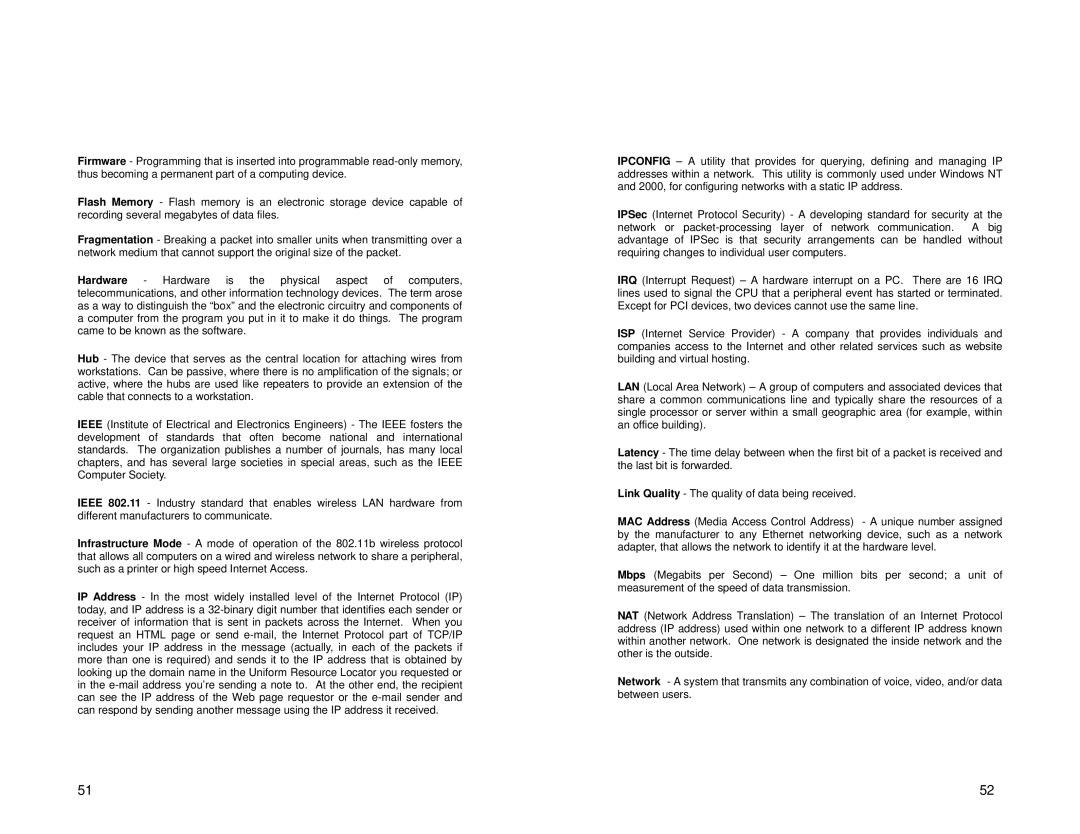Firmware - Programming that is inserted into programmable
Flash Memory - Flash memory is an electronic storage device capable of recording several megabytes of data files.
Fragmentation - Breaking a packet into smaller units when transmitting over a network medium that cannot support the original size of the packet.
Hardware - Hardware is the physical aspect of computers, telecommunications, and other information technology devices. The term arose as a way to distinguish the “box” and the electronic circuitry and components of a computer from the program you put in it to make it do things. The program came to be known as the software.
Hub - The device that serves as the central location for attaching wires from workstations. Can be passive, where there is no amplification of the signals; or active, where the hubs are used like repeaters to provide an extension of the cable that connects to a workstation.
IEEE (Institute of Electrical and Electronics Engineers) - The IEEE fosters the development of standards that often become national and international standards. The organization publishes a number of journals, has many local chapters, and has several large societies in special areas, such as the IEEE Computer Society.
IEEE 802.11 - Industry standard that enables wireless LAN hardware from different manufacturers to communicate.
Infrastructure Mode - A mode of operation of the 802.11b wireless protocol that allows all computers on a wired and wireless network to share a peripheral, such as a printer or high speed Internet Access.
IP Address - In the most widely installed level of the Internet Protocol (IP) today, and IP address is a
IPCONFIG – A utility that provides for querying, defining and managing IP addresses within a network. This utility is commonly used under Windows NT and 2000, for configuring networks with a static IP address.
IPSec (Internet Protocol Security) - A developing standard for security at the network or
IRQ (Interrupt Request) – A hardware interrupt on a PC. There are 16 IRQ lines used to signal the CPU that a peripheral event has started or terminated. Except for PCI devices, two devices cannot use the same line.
ISP (Internet Service Provider) - A company that provides individuals and companies access to the Internet and other related services such as website building and virtual hosting.
LAN (Local Area Network) – A group of computers and associated devices that share a common communications line and typically share the resources of a single processor or server within a small geographic area (for example, within an office building).
Latency - The time delay between when the first bit of a packet is received and the last bit is forwarded.
Link Quality - The quality of data being received.
MAC Address (Media Access Control Address) - A unique number assigned by the manufacturer to any Ethernet networking device, such as a network adapter, that allows the network to identify it at the hardware level.
Mbps (Megabits per Second) – One million bits per second; a unit of measurement of the speed of data transmission.
NAT (Network Address Translation) – The translation of an Internet Protocol address (IP address) used within one network to a different IP address known within another network. One network is designated the inside network and the other is the outside.
Network - A system that transmits any combination of voice, video, and/or data between users.
51 | 52 |
